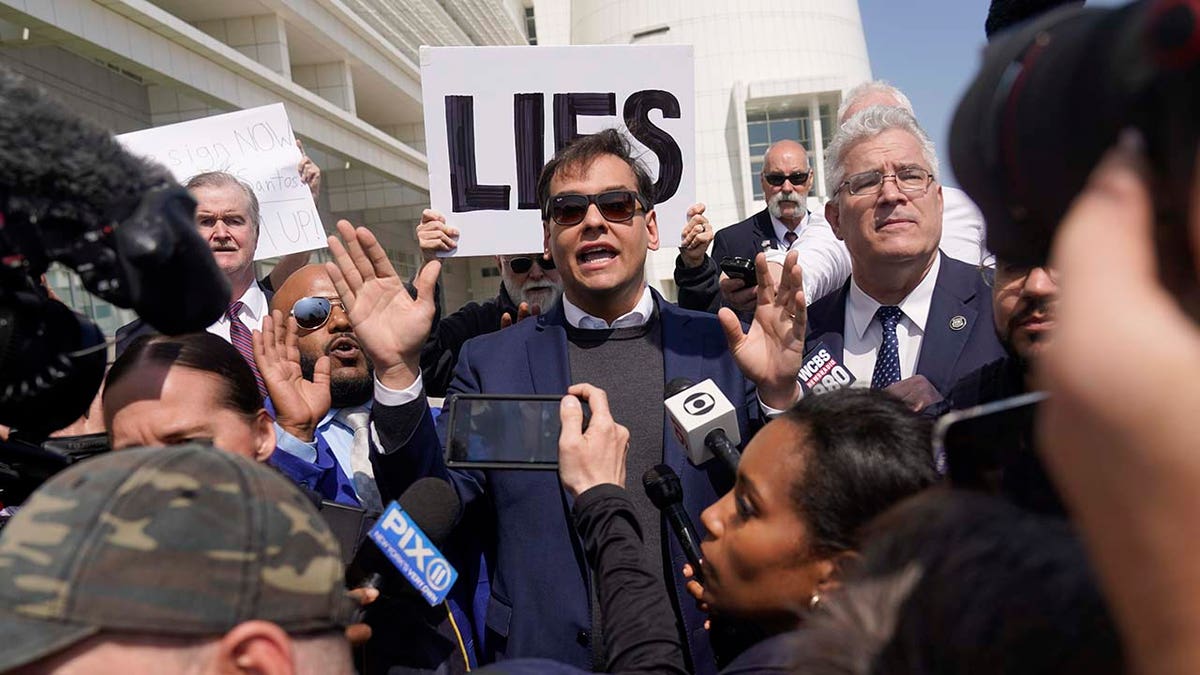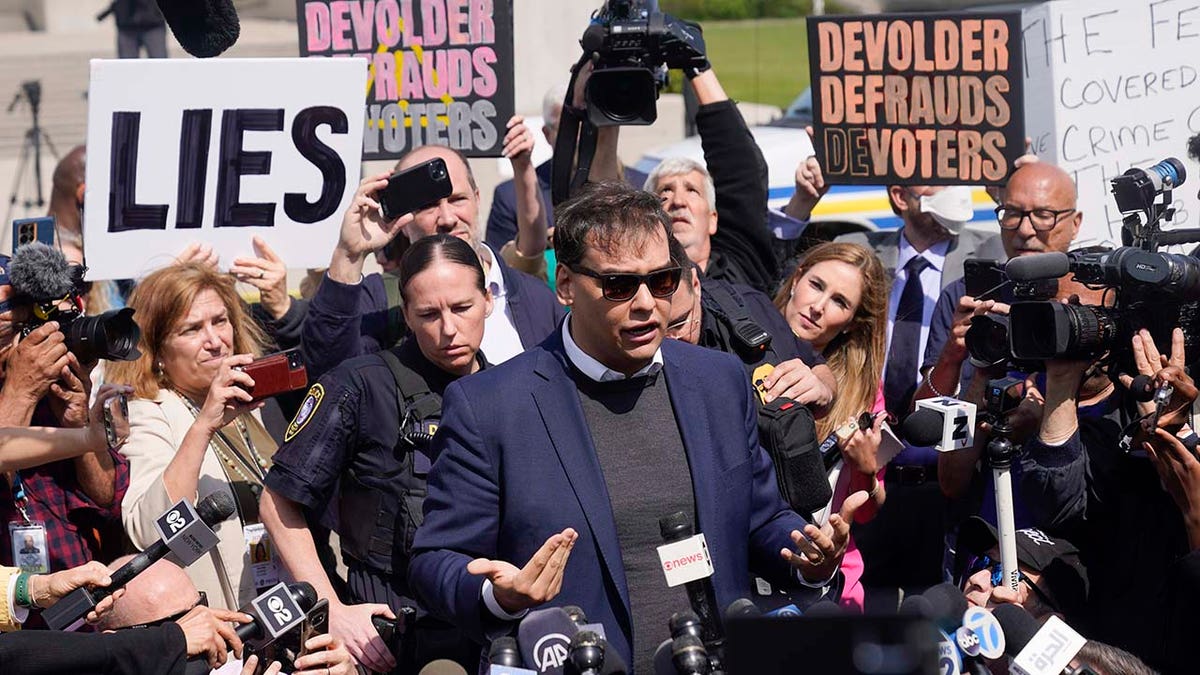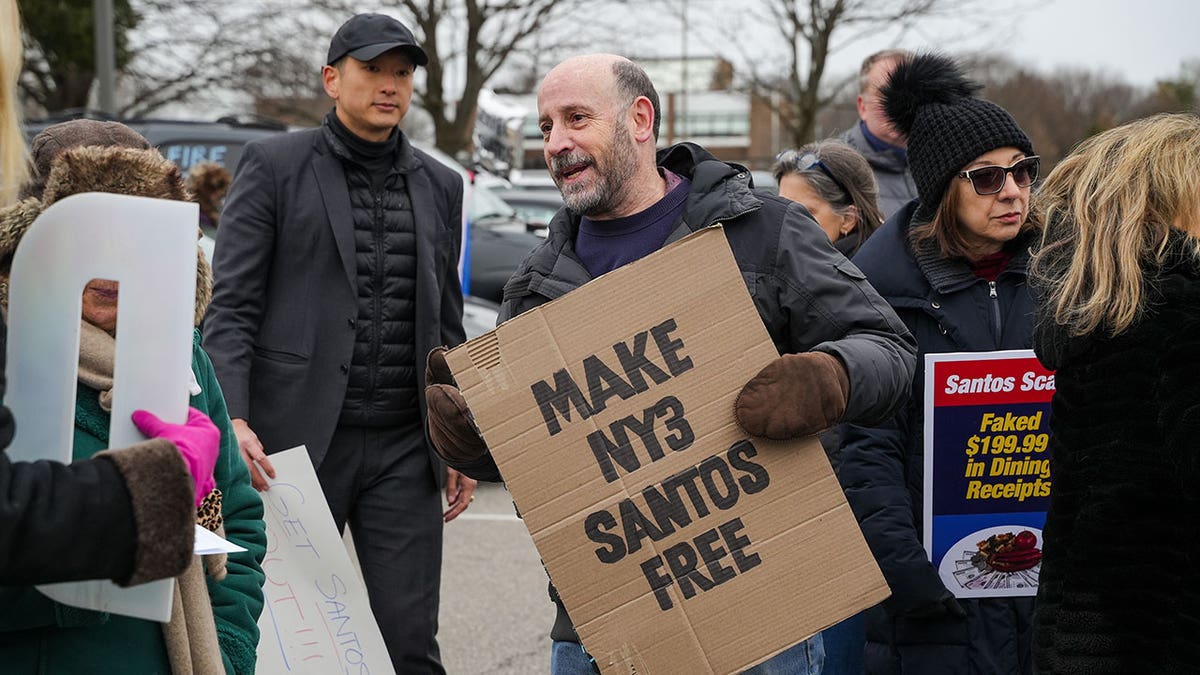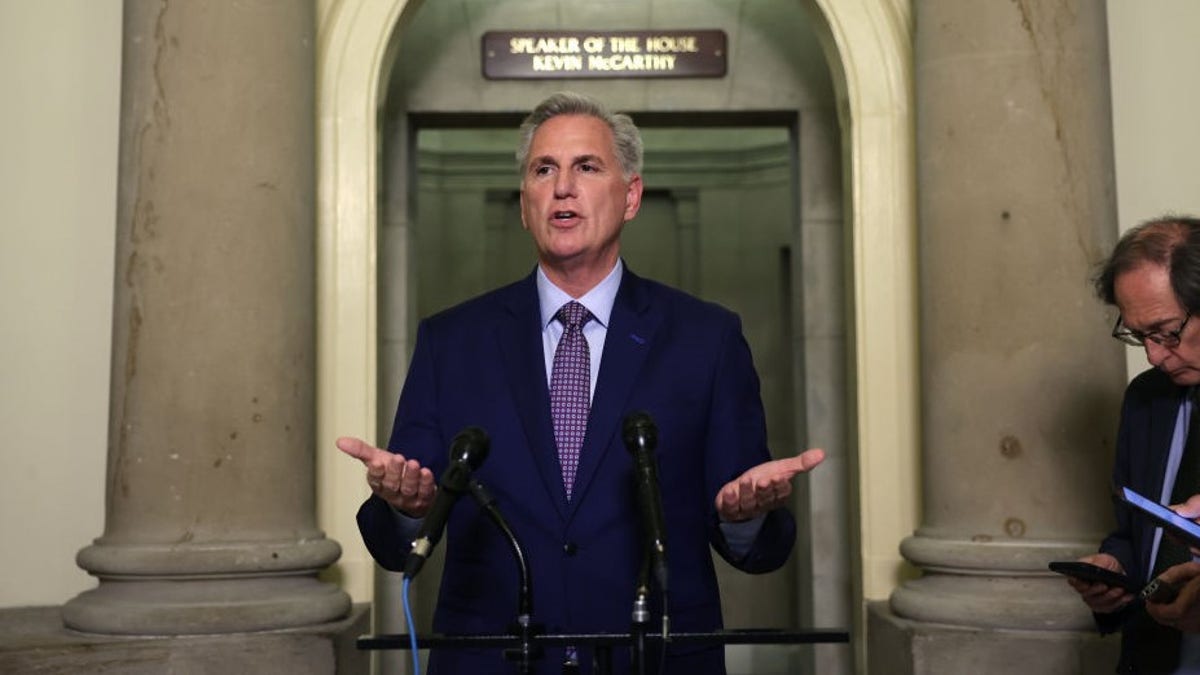Rep. George Santos addresses federal charges: I’m going to clear my name
Rep. George Santos, R-N.Y., speaks out after being charged with several federal crimes including fraud and money laundering.
A key part of politics is making the other side sweat.
For House Democrats, one way to make House Republicans sweat involves moving to expel Rep. George Santos, R-N.Y., who was indicted on a host of charges. Rep. Robert Garcia, D-Calif., offered a privileged resolution on the floor Tuesday afternoon to expel Santos from Congress.
Santos pleaded not guilty last week to charges that he lied to Congress about his personal wealth, pocketed unemployment checks he did not qualify for, stole cash from his campaign and hornswoggled donors.
House Minority Leader Hakeem Jeffries, D-N.Y., and other key Democrats have repeatedly punted the question of Santos’ fitness for office to House Speaker Kevin McCarthy, R-Calif. The question prior to Tuesday was why Democrats — if they really think Santos is so ill-suited to serve — had not tried to oust Santos from Congress.

Rep. George Santos, R-N.Y., leaves the federal courthouse in Central Islip, New York, Wednesday May 10, 2023. Santos, the New York Republican infamous for fabricating his life story, pleaded not guilty Wednesday to charges he duped donors, stole from his campaign and lied to Congress about being a millionaire, all while cheating to collect unemployment benefits he did not deserve. Afterward, he said would not drop his re-election bid, defying calls to resign. (Seth Wenig)
With Garcia's resolution, Democrats have a chance to use the expulsion process to put Republicans in the hot seat.
Any member — even a Democrat — has the tools at their disposal to force an expulsion vote in the House.
However, Jeffries says he has not spoken yet with various members of his caucus who want to expel Santos, nor has he had a conversation about Santos with McCarthy.
Jeffries says they have been consumed of late by the debt ceiling talks.
JOE BIDEN WAS GEORGE SANTOS BEFORE GEORGE SANTOS WAS GEORGE SANTOS
However, there is a process to throw someone out of the House.
The Constitution gives the House and Senate control of which Members are seated in their bodies. Article I, Section 5 of the Constitution grants lawmakers the right to expel fellow lawmakers — although the Constitution is vague on justifications for expulsion. There is no Constitutional "code of conduct" or anything like that.
When it comes to booting a lawmaker, any member from either party may introduce a "privileged resolution" to expel Santos. By its nature, the House must consider a privileged resolution immediately or within a two-day window. An expulsion requires a two-thirds vote, 290 of 435 if everyone is voting.

House Democratic Leader Hakeem Jeffries. (Kevin Dietsch)
The House has only expelled five members in its history. The House kicked out several members 160 years ago after they sided with the Confederacy. The House voted to remove former Rep. Michael "Ozzie" Meyers, D-Penn, after taking bribes in connection with the FBI’s "Abscam" sting operation in 1980. The House also threw out late Rep. Jim Traficant, D-Ohio. Traficant refused to resign after his conviction on a host racketeering, bribery and tax-related offenses.
Here is the gambit if Democrats were to try to expel Santos:
There are a lot of Republicans who have called for Santos to "resign" or declared he is not fit for office. So, a Democratic resolution to expel Santos would put Republicans on the spot. Democrats would likely have all 213 of their members vote to expel Santos. However, they still need 77 Republicans to hit the 290 vote threshold. Democrats would love to have Republicans make a stand: either they vote to expel Santos or they back him.
Undoubtedly, there are dozens of Republicans who would vote to expel Santos in a heartbeat. Some of the most vocal anti-Santos critics have been freshman Republican members elected in suburban New York City who flipped districts from blue to red last year.
HOUSE GOP LEADERS REACT TO SANTOS INDICTMENT: ‘THERE IS A LEGAL PROCESS’
If the House secures two-thirds of its members to expel Santos, the deed is done. Even so, Democrats can point to the GOP members who voted against expulsion. That is politically explosive in and of itself. Moreover, Democrats will have documented a toxic vote for the GOP if Republicans stand with Santos and do not expel him. Democrats and the Democratic Congressional Campaign Committee — the Democrats’ organization in charge of electing Democrats — could then weaponize the expulsion roll call vote against vulnerable Republicans from swing districts.

U.S. Rep. George Santos leaves the federal courthouse in Central Islip, New York, Wednesday, May 10, 2023. (Seth Wenig)
However, Republicans could try to dodge the bullet.
On the floor, McCarthy or a Santos ally could move to table the Democrats’ resolution to expel Santos or move to refer it to the Ethics Committee — even though the Ethics Committee is already investigating Santos. The House then votes — not on expelling Santos — but euthanizing the effort to kick him out. The actual roll call vote is one parliamentary step removed from an expulsion vote for Santos.
If the House votes to table, the game is up. Santos remains in the House. If the House votes to send the resolution to committee, that extinguishes it, also. Simple majorities are needed for those roll call votes. Republicans will have avoided a straight up or down vote on Santos’s future and can argue they did not cast a vote to expel or retain him. However, Democrats could also use those roll call votes against the GOP. Democrats would argue that the GOP cannot even bring themselves to expel Santos and are protecting the New York Republican. Either outcome works politically for Democrats.
GEORGE SANTOS, NATONAL PUNCHLINE, HIT WITH CRIMINAL CHARES OVER WEB OF LIES
Democrats can also make mischief for Republicans in another way.
Say the House votes to expel Santos. He becomes the sixth member expelled from the House in U.S. history and the first since 2002.
Santos’s seat on Long Island is vacant. The governor cannot appoint someone to fill his seat. There must be a special election to fulfill the remainder of Santos’s term. Santos flipped that seat from Democratic to Republican in 2022. Democrats believe they have a better than even chance of winning that seat back.

Guests attend "Drive Out Santos: Constituent Caravan Across NY-03" on Feb. 25, 2023 in New Hyde Park, New York. (Sean Zanni)
However, it is about the math.
If the House expelled Santos, the new breakdown in the House would be 221 Republicans and 213 Democrats. There are 434 members. 218 is the magic number to pass anything. So, McCarthy’s margin slips from four votes to three.
Moreover, if Democrats were to win a hypothetical special election in Santos’s district, the breakdown would be 221 Republicans and 214 Democrats with 435 members. The magic number to pass a bill is still 218. However, McCarthy can still only lose three votes.
So, it is unclear why Democrats will not execute this gambit to expel Santos or, at the very least, make Republicans sweat and give them headaches.
Ironically, one senior Democratic House aide wondered if it may be better to allows Santos to remain in Congress. There is always need for a foil in politics. Democrats could convert Santos and his ethics woes as a poster child for the GOP, emblematic of all that is wrong with the other side.
Additionally, the debt ceiling is looming. One Congressional source sardonically wondered if even Democrats need Santos to remain in Congress to approve some sort of bill to deal with the debt ceiling. Any vote on the debt ceiling will be tight. Ironically, it could serve the country better if Santos is present to help pull any legislation across the finish line and avoid default.

Speaker of the House Kevin McCarthy. (Alex Wong)
It is not unprecedented for lawmakers to try to engineer the ouster of their fellow Members if they face serious legal issues.
Former Rep. Jim Sensenbrenner, R-Wisc., introduced expulsion resolutions — notably for Traficant and former Rep. Walter Tucker, D-Calif. A federal court convicted Tucker of extortion and tax evasion charges. He resigned before the House ever took action on Sensenbrenner’s resolution.
That said, it is not unprecedented for the House and Senate to try to evict one of its members and fail.
The Senate attempted to evict four of its members and failed between 1808 and 1919. The Senate also had the votes to expel late Sen. Bob Packwood, R-Ore., in the mid-1990s after claims of sexual harassment, but Packwood resigned before expulsion proceedings advanced against him.
The Senate tried to banish Sen. Reed Smoot, R-Utah, in 1907. Smoot was a Mormon and there were suspicions about him serving in the Senate. In fact, the House blocked Smoot from serving because of a charge that he had multiple wives. The Senate ultimately voted 42-28 against giving Smoot the boot.
WHAT THE INDICTMENT MEANS FOR REP GEORGE SANTOS: WILL HE BE KICKED OUT OF CONGRESS?
In 1919, the Senate tried to bounce Sen. Robert La Follette, R-Wisc., because he sided with the Bolsheviks during the 1917 Russian Revolution. The effort failed 50-21.

Rep. George Santos, R-N.Y., and Rep. Matt Gaetz, R-Fla., are seen being sworn in by Speaker of the House Kevin McCarthy as members of the 118th Congress. (Alex Brandon)
The most famous, unsuccessful attempt to expel a lawmaker involved Rep. Preston Brooks, D-S.C., after he caned Sen. Charles Sumner, R-Mass., in the Senate chamber. The House voted 121-95 in favor of Brooks staying on. However, Brooks later resigned, ran for his seat again in a special election and won. However, Brooks died before he could take office in 1857.
The House also rejected the expulsion of Lovell Rousseau, D-Ky., in 1866 after he attacked Rep. Josiah Grinnell, R-Iowa.
The House also voted down an attempted expulsion of former Rep. Barney Frank, D-Mass., in 1990. Some lawmakers wanted Frank expelled because of his relationship with Stephen Gobie. Gobie was Frank’s sexual partner in the mid-1980s and claimed he ran a homosexual prostitution ring out of Frank’s Capitol Hill apartment. The expulsion effort failed, 390-38.
As always, any effort to kick out Santos will be about the math.
CLICK HERE TO GET THE FOX NEWS APP
However, it is also about political will.
The question is whether Democrats have the will to follow through. Even with a character as murky as George Santos.






